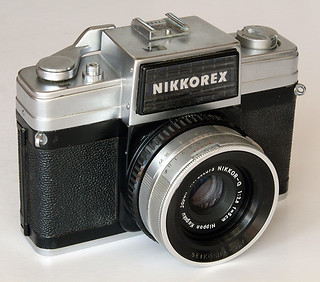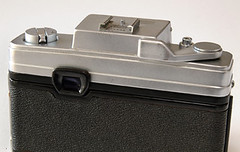Difference between revisions of "Nikkorex 35"
m (Minor layout adjustment) |
m (Present tense) |
||
| Line 10: | Line 10: | ||
}} | }} | ||
| − | The [[Nikon]] '''Nikkorex 35''' | + | The [[Nikon]] '''Nikkorex 35''' is a [[35mm film|35mm]] [[leaf shutter]] [[SLR]] released in 1960. After the [[Contaflex (SLR)]], launched in 1953, there was a trend of leaf shutter SLR's for the medium price range. At the beginning of the 1960s, many Japanese makers made their own leaf shutter SLR, but none of them was very reliable, the Nikkorex 35 being no exception. |
| − | The Nikkorex 35 | + | The Nikkorex 35 has a [[Citizen]] MVL shutter from 1s to 1/500 and a fixed Nikkor-Q 50/2.5 lens. The [[reflex finder]] uses mirrors (porro configuration) instead of a [[pentaprism]]. The viewfinder eyepiece is offset to the left of the body, and the finder screen is equipped with a split image device. The Nikkorex 35 did not have an instant return mirror, and is subject to finder blackout after each exposure. The special finder configuration resulted in a squarish looking body, with a big [[selenium meter]] in front of the mirror housing. The meter is coupled, and the exposure reading is displayed in the viewfinder and on the top plate under a window. The ISO setting is around the lens. There is a lever advance, a rewind crank, strap lugs, a [[flash sync]] socket and a fixed accessory shoe. |
{{Flickr_image | {{Flickr_image | ||
| Line 33: | Line 33: | ||
{{br}} | {{br}} | ||
| − | The '''Nikkorex 35|2''' | + | The '''Nikkorex 35|2''' is essentially the same camera with the Citizen shutter replaced by a [[Seikosha-SLV]], a slight redesign of the body's external shape, and a ''Nikkorex'' marking on the meter's window. It replaced the Nikkorex 35 in 1962. It is said it was developed because the original model was not reliable enough. It is often called '''Nikkorex 35 II''', but the box and user manual read "Nikkorex 35|2" (see pictures [http://www3.pf-x.net/~ari/body/nikorex/35II/index.html here]). |
| − | Two optical complements were made for the Nikkorex 35 and 35|2, a wide angle 35mm (or 38mm?) f/5.6 and a tele f/5.6 (equivalent 90mm). They | + | Two optical complements were made for the Nikkorex 35 and 35|2, a wide angle 35mm (or 38mm?) f/5.6 and a tele f/5.6 (equivalent 90mm). They are screwed in front of the lens. |
At Nikon's corporate site, [http://imaging.nikon.com/products/imaging/technology/cousins/cousins01-e/index.htm an article] mentions a prototype with a dual finder, switchable from reflex to direct vision by moving a mirror. | At Nikon's corporate site, [http://imaging.nikon.com/products/imaging/technology/cousins/cousins01-e/index.htm an article] mentions a prototype with a dual finder, switchable from reflex to direct vision by moving a mirror. | ||
| Line 41: | Line 41: | ||
==Interchangeable-lens version== | ==Interchangeable-lens version== | ||
| − | The [[Nikkorex F]] | + | The [[Nikkorex F]] is an entry-level SLR using the normal Nikon F lens mount. It was actually manufactured by [[Mamiya]]. |
== Zoom version == | == Zoom version == | ||
| Line 65: | Line 65: | ||
}} | }} | ||
| − | The '''Nikkorex Auto 35''', introduced in 1964, was an evolution of the Nikkorex 35|2. The porro mirror finder was replaced by a pentaprism, the finder eyepiece was centered, and the mirror was now of the instant return type. The new camera had auto exposure with shutter priority, like the [[Voigtländer]] [[Voigtländer Ultramatic|Ultramatic]] or the [[Zeiss Ikon]] [[Contaflex Super B]]. It also had a new design, with the advance lever hidden underneath the top plate, and the shutter release in front of the body. The lens | + | The '''Nikkorex Auto 35''', introduced in 1964, was an evolution of the Nikkorex 35|2. The porro mirror finder was replaced by a pentaprism, the finder eyepiece was centered, and the mirror was now of the instant return type. The new camera had auto exposure with shutter priority, like the [[Voigtländer]] [[Voigtländer Ultramatic|Ultramatic]] or the [[Zeiss Ikon]] [[Contaflex Super B]]. It also had a new design, with the advance lever hidden underneath the top plate, and the shutter release in front of the body. The lens is a fixed Nikkor 48/2. Optical complements were sold, resulting in a 35/4 or a 85/4. |
It is known with '''Nikkorex Auto 35''' or '''Nikon Auto 35''' markings, apparently there is no difference between both variants. | It is known with '''Nikkorex Auto 35''' or '''Nikon Auto 35''' markings, apparently there is no difference between both variants. | ||
Revision as of 03:53, 1 November 2018
First version

|
| Nikkorex 35 image by Grace Oda (Image rights) |
The Nikon Nikkorex 35 is a 35mm leaf shutter SLR released in 1960. After the Contaflex (SLR), launched in 1953, there was a trend of leaf shutter SLR's for the medium price range. At the beginning of the 1960s, many Japanese makers made their own leaf shutter SLR, but none of them was very reliable, the Nikkorex 35 being no exception.
The Nikkorex 35 has a Citizen MVL shutter from 1s to 1/500 and a fixed Nikkor-Q 50/2.5 lens. The reflex finder uses mirrors (porro configuration) instead of a pentaprism. The viewfinder eyepiece is offset to the left of the body, and the finder screen is equipped with a split image device. The Nikkorex 35 did not have an instant return mirror, and is subject to finder blackout after each exposure. The special finder configuration resulted in a squarish looking body, with a big selenium meter in front of the mirror housing. The meter is coupled, and the exposure reading is displayed in the viewfinder and on the top plate under a window. The ISO setting is around the lens. There is a lever advance, a rewind crank, strap lugs, a flash sync socket and a fixed accessory shoe.

|
| Nikkorex 35-2 image by Geoff Harrisson (Image rights) |

|
| Nikkorex 35-2 rear showing finder eyepiece position image by Geoff Harrisson (Image rights) |
The Nikkorex 35|2 is essentially the same camera with the Citizen shutter replaced by a Seikosha-SLV, a slight redesign of the body's external shape, and a Nikkorex marking on the meter's window. It replaced the Nikkorex 35 in 1962. It is said it was developed because the original model was not reliable enough. It is often called Nikkorex 35 II, but the box and user manual read "Nikkorex 35|2" (see pictures here).
Two optical complements were made for the Nikkorex 35 and 35|2, a wide angle 35mm (or 38mm?) f/5.6 and a tele f/5.6 (equivalent 90mm). They are screwed in front of the lens.
At Nikon's corporate site, an article mentions a prototype with a dual finder, switchable from reflex to direct vision by moving a mirror.
Interchangeable-lens version
The Nikkorex F is an entry-level SLR using the normal Nikon F lens mount. It was actually manufactured by Mamiya.
Zoom version

|
| Nikkorex Zoom 35 image by eBayer retrovintagecool (Image rights) |
The Nikon Nikkorex Zoom 35, introduced in 1963, was based on the Nikkorex 35|2 with a fixed Zoom Nikkor Auto 43-86mm f/3.5 zoom lens. In some way, it was an ancestor of the bridge cameras. This lens was later released in Nikon F mount.
Auto-exposure version

|
| Nikkorex Auto 35 image by Terri Monahan (Image rights) |
The Nikkorex Auto 35, introduced in 1964, was an evolution of the Nikkorex 35|2. The porro mirror finder was replaced by a pentaprism, the finder eyepiece was centered, and the mirror was now of the instant return type. The new camera had auto exposure with shutter priority, like the Voigtländer Ultramatic or the Zeiss Ikon Contaflex Super B. It also had a new design, with the advance lever hidden underneath the top plate, and the shutter release in front of the body. The lens is a fixed Nikkor 48/2. Optical complements were sold, resulting in a 35/4 or a 85/4.
It is known with Nikkorex Auto 35 or Nikon Auto 35 markings, apparently there is no difference between both variants.
Bibliography
- Nikon Saga, P-H Pont, ed. Fotosaga
Links
In English:
- Nikkorex 35 and 35II, Nikkorex Zoom 35 and Nikon Auto 35, at Nikon's History & Technology site
- Pages at Photography in Malaysia:
In German:
In French:
In Japanese: